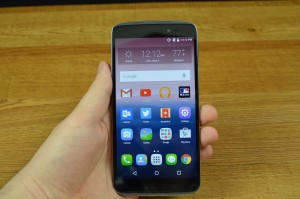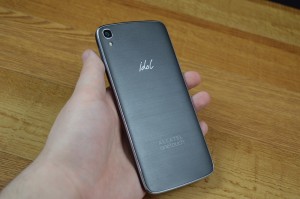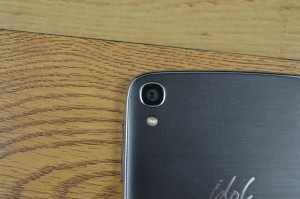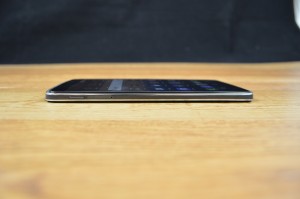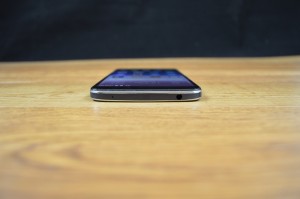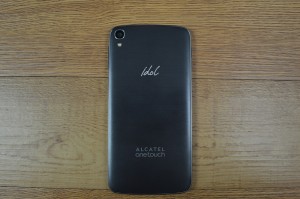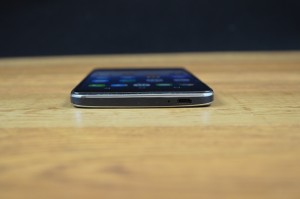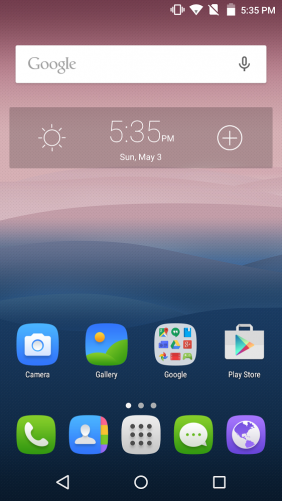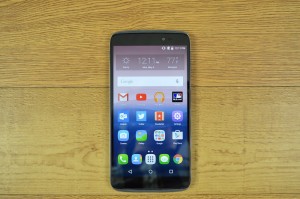QUICK TAKE
The Alcatel OneTouch Idol 3 is the best sub-$300 Android phone to date. Like the OnePlus One, Nexus 5, and Moto G before it, it's an encouraging step towards ending the neglect typically faced by the low end of the smartphone market.
Good smartphones are too expensive. With the claws of the annual release cycle entrenched in the mobile market, the upgrades today’s high-end devices receive over their predecessors have become less and less significant. You can’t see the difference between a 5-inch 1080p display and a 5-inch 1440p one. The Snapdragon 810 isn’t letting you run anything the Snapdragon 801 couldn’t. There are only so many ways to show square icons in a grid, all performing similar tricks. You now get to charge your battery at 11am tomorrow instead of 11pm tonight. You can have your screen curved, because why not. The best smartphones are still miraculous things, and their yearly changes still make things better (usually), but the extent to which they do is shrinking. For that nebulous list of requirements we call “most people’s needs,” flagships have long since hit the point of diminishing returns.
Yet the cost of those flagship phones remains the same. Year after year, the public is sold something incrementally superior under the guise of something revolutionary, the phone makers collect their $650, and the carriers get their fresh batch of contracts. The slightly older phones are left behind, despite being plenty capable. The upgrades are staggered: This year the build gets improved, but wait until next year for the software problems to be cleaned up.
On the other end, most affordable alternatives are designed to be subpar, neglecting niceties like quality materials in order to push you towards the higher tier. The market gets stuck with few exceptions willing to try something legitimately different. Most people just accept this, because having something deemed “the best” feels nice. The geekier among us will find the value in a slight spec bump or design refinement–and more power to them–but those who just want something “good enough” are usually paying for more than they need.
Which makes phones like the Alcatel OneTouch Idol 3 all the more essential. The finest handset this often irrelevant OEM has ever produced, the Idol 3 follows in the footsteps of the Moto G, OnePlus One, and Google’s Nexus phones by providing a refined experience at a price that doesn’t inflate its worth. For $250 unlocked, it brings a 5.5-inch 1080p display, a still useful Snapdragon 615 chipset, a beefy 2910 mAh battery, a light build with two powerful speakers, Android 5.0, and LTE connectivity. It’s a device that’s realistic about how far phones have progressed–nothing is world-class, but that doesn’t mean it’s incompetent. Instead, it’s another encouraging step towards lessening the gap between the contrived haves and have-nots of the smartphone world.
Let’s take a closer look at the device, which goes on sale later this month through Amazon and Alcatel itself. Please note that we’re reviewing the 5.5-inch version of the device–there’s also 4.7-inch model that will come with lesser specs across the board.
Build and Design
The Idol 3 isn’t the kind of phone that constantly reminds you that it’s inexpensive, but its design isn’t ever going to touch the classier digs of a Galaxy S6, One M9, or iPhone 6. Higher-quality build materials are most of what you’re paying for with those upper-tier devices; with something as affordable as the Idol 3, you’re still going to have a hard time avoiding plastic.
The good news is that this specific plastic doesn’t feel explicitly cheap. It’s smooth and understated, with a faint brushed pattern that feels as if it was crafted with care. For a point of comparison, it’s reminiscent of the comfortable material that made up the rear of the LG G3. The 13-megapixel camera on its back is neatly flattened and tucked away in the top left corner, while a pair of logos underneath that similarly avoids ostentatiousness. The slick chrome-like trim wrapped around the phone is really the only thing that screams budget, but even then it looks fine and covers the softly rounded edges. In general, the whole phone is tightly fused together, with no real creakiness or flex to the exterior materials.
Per usual, one benefit of deploying all this plastic is that it keeps the phone light–at 141 grams, the Idol 3 isn’t nearly as hefty as most phablets. It’s also thin (officially measuring 152.7 x 75.1 x 7.4 mm), and for a phone with a 5.5-inch screen, it isn’t particularly unwieldy either. It’s inherently going to be too big for most to use easily with one hand, but with its reasonably sized bezels and small front-facing speakers, it doesn’t waste much of the space it consumes. The fact that its power key and volume rocker (the only physical buttons here) sit in a more natural resting position near the top edges also helps make it a little more inviting to grasp.
It isn’t something with a distinct aesthetic, but the Idol 3 avoids the common budget phone trap of being another bland box. It’s the modest yet pleasant sort of design that we should expect out of most phones in this price range.
Display
The aforementioned 5.5-inch, 1080p IPS LCD display is the Idol 3’s main attraction. In a vacuum, it’s good. In context, it’s phenomenal. Virtually everything required of a good smartphone screen is checked off here: Its colors are lively and accurate; its darker tones are fairly deep; its viewing angles are wide and don’t wash out objects on screen; it’s capable of intense brightness; it stays visible in sunlight; and with a pixel density of 401 ppi, it has no real issues with sharpness.
It can’t match the brilliant contrast of a top-tier OLED panel like the Galaxy S6’s, and it’s somewhat prone to smudges, but very few people would bat an eyelash if this screen was on a phone twice as expensive. It’s more evidence that the rung below the highest-end mobile tech is still beyond serviceable.
Performance
There aren’t many instances in which the Idol 3 acts like a traditional $250 smartphone, but if you are to come across any, you’ll probably find them in the device’s performance. The included 1.5GHz Snapdragon 615 is technically a 64-bit, octa-core chipset, but those specs only make the device sound more proficient than it really is.
In practice, everything is just average. You can play any game in the Google Play store or run a bunch of apps simultaneously if you’d like, but it’ll run hot and start to stutter sooner than most higher-end handsets when you push it. It takes a moment or two for most programs to load by default, it isn’t particularly fast to boot up, and it isn’t uncommon to find a faint bit of input lag across anything you’re doing. We also had one instance where the device froze while launching and required a hard reset, although an Alcatel rep chalked that up to us using a pre-release model for our tests.
Today’s upper-class chipsets don’t bring dramatic everyday improvements compared to their direct predecessors, you can only go so far back down the line until things start to suffer. The Snapdragon 615 is just a little too dated to really compare to today’s flagships the way the rest of the phone does. In the context of its fellow value phones, it’s superior to the Moto G, but altogether inferior to the OnePlus One.
All that said, things never slow down enough to make the phone unusable. The dropoff from a modern flagship is noticeable, but not crippling, and if you’re coming from another handset in this price range, it’ll likely be an upgrade. It’s perfectly adequate for most tasks, and another reminder that yesterday’s specs are far from useless.
On top of that, just about all of the more “peripheral” performance-related items here are great. Call quality was perfectly fine on T-Mobile’s network here in Boston, as was LTE performance (something the most recent Moto G doesn’t have). The pair of front-facing JBL speakers are especially fantastic, capable of producing very loud sound while retaining most audio’s nuance and quality. They don’t have the bass-y oomph of the HTC One’s BoomSound setup, but they’re better than what you’d get on most $650 devices, let alone $250 ones.
Our unit only had 11 GB of usable storage space by default–out of 16, though there’s a dual-SIM model that comes with 32 GB–but that can be expanded through a microSD card, a feature that’s unfortunately getting rarer and rarer amongst pricier devices today.
Battery Life
There are few quibbles to be had over the Idol 3’s battery life. With average use, the 2910 mAh pack here lasted us well over a day, oftentimes retaining around half of its juice by the end of a given night. It’s entirely feasible to get a couple of days out of one charge if you pay just a little attention to how hard you’re pushing the phone. Throwing in some games and running numerous tasks at once will drive things down a bit, naturally, but even then you basically have to go out of your way to kill the whole thing off before bedtime. The one negative here is that the battery is non-removable, but given its large capacity and the average chipset that accompanies it, we can’t see that becoming an issue for some time.
Software
Like the Nexus 5, Moto G, and OnePlus One before it, the Idol 3 doesn’t betray its power-on-a-budget setup with any thick or convoluted software skin. Its version of Android 5.0.2 Lollipop is barely touched out of the box, with all the friendly animations, menus, and flourishes associated with Google’s Material Design aesthetic. (It comes with its downsides, too, but there’s still more good than bad to Lollipop.) It’s immediately easy to navigate if you’re at all familiar with Android, and the few changes and additions that are here aim to enhance the OS rather than modify it entirely. It’s baffling how cheaper phones like this are offering cleaner and more current interfaces than their pricier competitors, but here we are.
That said, there are additions here, and they have varying degrees of utility. The cutesy icon designs Alcatel uses for its own apps are harmless enough, but those are joined by a handful of pre-installed programs like AVG AntiVirus, a lite version of the Facetune photo editing app, WhatsApp, WPS Office, and Flipboard. A couple of those are genuinely common, and all of them can be uninstalled, but bloatware is bloatware.
Besides that, there’s the handy ability to double-tap the screen whenever you want to wake or sleep it, which is thankfully becoming more common. There’s also a fun little toggle in the settings menu that allows the display to reorient itself if you’re holding the phone upside down–something that, as far as we can tell, has not been done on a smartphone to date. There’s a reason for that (hint: it’s isn’t exactly an endemic problem) but for disabled users or anyone who pulls their phone out of their pocket the wrong way, it’s a simple way around that inconvenience. Since there’s a microphone and speaker at both ends the display, you don’t lose much functionality when using it.
Less useful are the handful of app shortcuts that Alcatel plops on the lock screen. They all work fine, allowing you to quickly jump to the front-facing camera, calculator, messenger app, and others with an easy double tap, but their icons look out of place next to the Lollipop’s default shortcuts, and Alcatel doesn’t go far enough with the idea. You can only use it for first-party apps, which isn’t the best if you use, say, Spotify, instead of the default music app. We can’t imagine many people begging for a shortcut to the QR code scanner either. Thankfully, this can all be turned off if it starts to feel too distracting for its own good.
Another noteworthy lock screen trick is something Alcatel calls “Eye-D,” which lets you unlock the Idol 3 by letting it scan your eyes. It actually does work as advertised, feeling appropriately futuristic in the process, and it doesn’t require too long of a setup. It takes a couple seconds longer than entering a simple PIN code or swipe pattern, but it should help anyone who wants that extra sense of security (or anyone who enjoys James Bond movies).
We did run into a couple of bugs during testing–we got booted into recovery mode on multiple occasions, for instance, and found that the double-tap to wake function was a little too overeager from time to time–but, again, Alcatel says those shouldn’t be an issue in the finished product. Either way, nothing ever felt like more than a minor hiccup.
Camera
The recurring idea with the Idol 3 is that it’s rarely on the level of the best flagships, but good enough to be at least close, which makes it superb for its price. It’s the same story with the phone’s 13-megapixel main camera, which is superior to some of the shoddier cams on high-end devices (hiya, One M9), but a few clear steps behind the likes of the Galaxy S6 and iPhone 6.
The cam shoots at 10-megapixels by default, so you have to manually upgrade to 13 if you want the largest shots possible, but either way it’s capable of capturing defined, well-saturated colors and good detail in ordinary outdoor conditions. It autofocuses quickly enough in such settings, and capturing 1080p video with it is similarly fine. Alcatel’s app is easy to follow for quick shots, too, while also allowing for more granular control of white balance, focus, shutter speed, and ISO if you want it. (Those settings could stand to be more obvious, though.) If you just want quality photos that you can share with your loved ones, this will easily do the trick.
Like most mid-range shooters, though, the Idol 3’s cam really lives or dies by your lighting. It isn’t as pathetic in low-light as something like the Moto G, but it isn’t good either, typically requiring a flash that blows out chunks of whatever you’re trying to capture. We’ve yet to see a high-performing budget phone really nail camera performance, so it’s really the one area where you have to go to the expensive, top-tier devices to get consistent quality. From a rear cam, at least: The 8-megapixel unit on the Idol’s front can hang with most other selfie takers, though it suffers from the same struggles in darker settings.
Conclusion
At a time when many phone makers find themselves changing their flagship phones for change’s sake to help justify keeping their high price points, there continues to be a need for phones like the Alcatel OneTouch Idol 3. Instead of building another device for tomorrow, Alcatel realizes that it’s 2015, and that there’s too much capable smartphone tech for it to be unavailable to wide swaths of people today.
The Idol 3 finds a comfortable middle ground between needlessly trashy low-cost smartphones and high-end phones that are only fit for early adopters and techies with money to burn. It’s cheaper than the OnePlus One, stronger than the Moto G, and actually on sale, unlike the Nexus 5. It also doesn’t tie you into the limiting pitfalls of a carrier contract. Ultimately, we’d say the One’s stronger processor keeps it as the best pure purchase on the market, but the Idol 3 is an outstanding value all the same.
Pros:
- Excellent value
- Vivid display
- Long-lasting battery
- Mostly clean take on Android
Cons:
- Average performance
- Camera underwhelms in low-light
- Parts of design feel cheap
